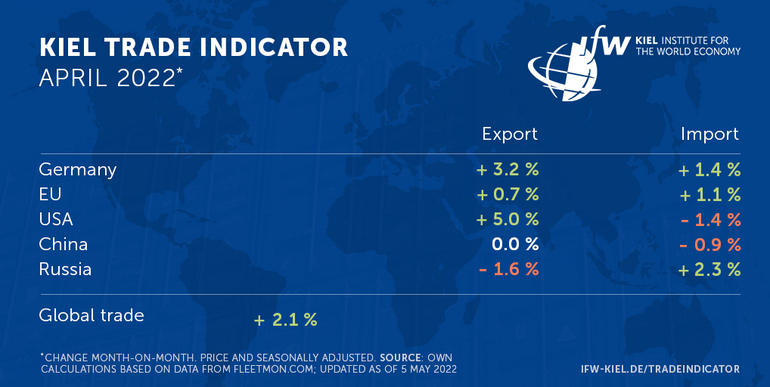News
Kiel Trade Indicator 04/22: World trade stabilizes

"The initial shockwaves of the Russian invasion of Ukraine to global trade in goods appear to have been digested and trade data in April is stabilizing. Almost all major economies can expect growth or at least a sideways movement," says Vincent Stamer, Head of Kiel Trade Indicator.
According to the latest Kiel Trade Indicator data update for April, world trade isexpected to increase by 2.1 percent compared with the previous month (price and seasonally adjusted). For Germany, ship movements suggest a positive trend compared to March, with both exports (+3.2 percent) and imports (+1.4 percent) up. The same applies to the EU, with exports likely to rise by 0.7 percent and imports by 1.1 percent.
In the USA, exports gain considerably in April, with growth of 5 percent, while imports are expected to fall by 1.4 percent. In China, both exports (0.0 percent) and imports (-0.9 percent) are expected to stagnate and thus trade remains at March levels.
"While the Shanghai lockdown is slowing export growth in China, declines in trade appear to be confined to the port of Shanghai. The gap in goods exports has leveled off at around 25 percent compared to China's other ports. But that also means that despite the lockdown, a large proportion of all goods are still leaving the port, which is a good sign for global supply chains," says Stamer.

Global congestion on the container ship network remains at a high level, with around 11 percent of all goods shipped worldwide stuck in congestion.

For Russia's trade, there are signs of a bottoming out in April after the partly severe slumps of the past three months. Compared with March, exports are likely to decline only moderately (-1.6 percent), while imports could increase (+2.3 percent).

"Russia may be starting to substitute imports from Europe with imports from Asia. This is indicated by the fact that the port of Novorossiysk in the Black Sea has recently seen a significant increase in the number of container ships arriving, whereas the port of St. Petersburg, which is involved in European trade, continues to record declines," says Stamer. "This could be a first indication of trade diversion. This makes it all the more important to create economic incentives for countries such as India to move closer to Europe rather than Russia."
The next update of the Kiel Trade Indicator will take place on May 20 (without press release) June 7 (with press release).
For more information on the Kiel Trade Indicator and forecasts for 75 countries and regions, visit www.ifw-kiel.de/tradeindicator.

About the Kiel Trade Indicator
The Kiel Trade Indicator estimates trade flows (imports and exports) of 75 countries and regions worldwide, the EU and world trade as a whole. Specifically, the estimates cover over 50 individual countries as well as regions such as the EU, sub-Saharan Africa, North Africa, the Middle East or emerging Asia. It is based on the evaluation of ship movement data in real time. An algorithm programmed at the Kiel Institute uses artificial intelligence to analyze the data and translates the ship movements into real, seasonally adjusted growth figures compared with the previous month.
We update the data twice a month. Around the 20th (without press release) for the current and the following month and around the 5th (with press release) for the previous and the current month.
Arriving and departing ships are recorded for 500 ports worldwide. In addition, ship movements in 100 maritime regions are analyzed and the effective utilization of container ships is derived from draught information. Country-port correlations can be used to generate forecasts, even for countries without their own deep-sea ports.
Compared to previous leading trade indicators, the Kiel Trade Indicator is available much earlier, is much more comprehensive, relies on a uniquely large database using big data, and has a low statistical error by comparison. The algorithm of the Kiel Trade Indicator uses machine learning, so that the quality of the forecast continues to improve over time.
